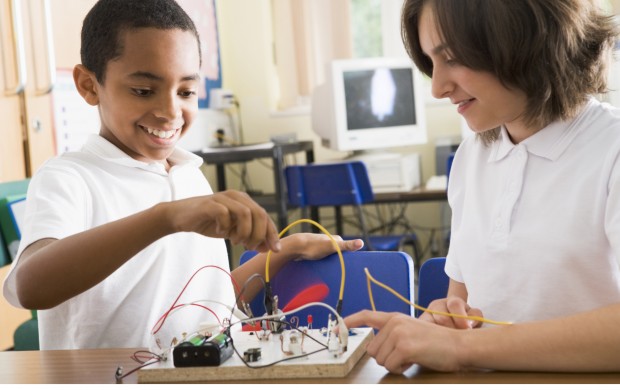4. AUTHOR A WRITING PROJECT. Budding writers can start a week-long writing project focused on a specific theme. Write about animal skeletons and types of clouds; or invent TV cartoon characters based on exotic animals, or spend the week writing about magic or food or chocolate. Re-imagine your favorite fairytales with your chosen theme. Write and draw short stories, poems, or illustrations inspired by the subject you’ve chosen. Turn the storytelling process upside down by using pictures and math equations to tell a story, or describe a classroom through a teacher's eyes, or describe the days of the week as if they were people. Find hundreds of writing prompts on this Tumblr blog.
5. BUILD A ROBOT. PR2, the $285,000 robot designed by Willow Garage, started with simple microcontroller programming. Kids can begin building their own robot creation by making a mini-kissing bug or an Animatronic Parrot. Explore the growing fields of embedded hardware, microcontroller programming, real world sensory systems using the Arduino microcontroller kit. Projects can be affordable and reproducible using parts available from a wide variety of sources.
6. FORM A BAND. The skills involved in learning music require daily practice, and starting a band can help motivate practice. Original composition is sparked through collaborating with other young musicians. Kids can put a band together and even record a single. YouTube hits are not far off.
7. SCULPT IN 3D. Anyone can be a high-tech sculptor with the right materials. Kids can start by selecting a stock 3D model using laser cut cardboard, then experiment with various construction techniques. Print the plans on your own material at home, or have the parts cut precisely and delivered to your doorstep. 2D plans and cut-patterns and assembly instructions are automatically generated. Assemble your project using simple tools like glue and pins. Instructions for beginning your project can be found here.
8. MAKE A FILM. The next Steven Spielberg might emerge from a summer movie-making project. Kids can exercise their writing, creativity, organization, and artistic skills by making their own movies, just as any director does: writing scripts, choosing actors, practicing lines, not to mention actually filming and editing. For those who own an Apple computer, iMovie makes the process very simple. YouTube also offers free editing, and you can find other editing software online.
9. DESIGN A CIRCUITRY PROJECT. Using electrically conductive non-toxic paint, design artwork with built-in circuits, like a paper house that glows from the inside. Tutorials and startup kits can be found online. The kits contain everything you need: a bare paint pen, 220K trim pots, 1KΩ resistors, 9V batteries, light dependent resistors, blue LEDs, Transistors, 470Ω resistor
and battery clips.
10. PAINT A MURAL. Kids can take the opportunity during the summer break to redesign their rooms, including painting a mural. First, they'll want to pick a theme (marine life, animals that live in a forest habitat, music, travel, video game characters) and use decoupage techniques to create the final mural. Practically any two-dimensional materials can be used for decoupage, including photos, cards, posters, wrapping paper, magazine clippings.


